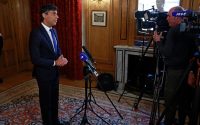Putin Vows to Make New Nuclear Missiles and to Weigh Placing Them Near NATO Nations
President Vladimir V. Putin declared on Friday that Russia would produce new intermediate-range nuclear-capable missiles and then decide whether to deploy them within range of NATO nations in Europe and American allies in Asia.
Mr. Putin’s threat was vaguely worded: He said nothing about timetables for deploying the weapons, and by blaming the United States for bringing similar missiles into training exercises in Europe and Asia, he seemed to be signaling he was open to negotiations.
But his timing was critical, because he made the announcement just as major elections were about to begin in Britain and France, and days ahead of the 75th anniversary NATO summit in Washington that starts on July 9. And it appeared to be Mr. Putin’s latest attempt to raise the stakes in his conflict with the West, coming less than two weeks after his visit to North Korea rattled nerves in the United States and those of American allies in Asia.
The United States pulled out of the 1987 Intermediate-Range Nuclear Forces Treaty in 2019, during the Trump administration, after years of American accusations that Russia was cheating on the accord. The treaty had banned U.S. and Russian forces from having land-based cruise or ballistic missiles with ranges between about 300 and 3,400 miles.
It was one in a series of treaty withdrawals that marked the end of more than a half-century of traditional nuclear arms control, in which the key agreements were negotiated in Washington and Moscow. Only one such treaty is left: New START, which limits the intercontinental weapons each nation can hold. It expires in February 2026.
Mr. Putin could have announced plans to bolster his force of intermediate weapons at any point in the past five years, so his decision to do it now was notable. In the interim, the Pentagon has moved to deploy some modified weapons in Asia, ultimately intended to counter a growing Chinese nuclear force. But the United States has not permanently redeployed any in Europe.
In brief, televised remarks in a videoconference with his national security officials on Friday, Mr. Putin referred to some recent military exercises in Denmark and suggested that it was possible the United States was preparing to leave weapons there.
“We need to respond to this and decide on our further steps in this regard,” Mr. Putin said. “It appears that we need to begin producing these attack systems and then, based on the actual situation, decide on where to deploy them to ensure our security, if necessary.”
But his motivation may simply be a reaction to recent American moves in Ukraine. When President Biden lifted his prohibition on Ukraine’s ability to fire American-supplied weapons into Russian territory — though he limited it to the area around Kharkiv, where Russia is firing weapons — Mr. Putin made clear there would be a response.
During the Cold War, such missiles were a key part of the Soviet force. But in the early 1990s, the United States removed from Europe all of its intermediate range ground-based nuclear cruise missiles and ballistic missiles, and the Soviets eliminated their SS-20 missiles. These moves were considered major steps in reducing tensions.
But a decade ago, Mr. Putin reversed Russia’s move, deploying Iskander missiles to Kaliningrad, the Russian region closest to Western European cities, which the Obama administration charged were in violation of the Intermediate Nuclear Forces treaty. But President Barack Obama decided not to withdraw from the treaty, reasoning that would lift any obligations from Mr. Putin. President Donald J. Trump reversed that decision.
The Pentagon has used the withdrawal to plan for the deployment of weapons in the Pacific that would have been previously banned under the treaty. But when military exercises are held, they almost always involve mock-ups, not real nuclear weapons.
The threat to produce more nuclear-capable missiles was also just the latest example of how Mr. Putin has tried to gain leverage in his war against Ukraine by invoking the power and reach of his nuclear arsenal. At the beginning of the invasion, he ordered weapons be put on a higher state of readiness — they apparently never were.
In October 2022, the Biden administration intercepted messages suggesting that Russian generals were planning to detonate a battlefield nuclear weapon in Ukraine, possibly at a military base. That crisis eased without any nuclear use.


